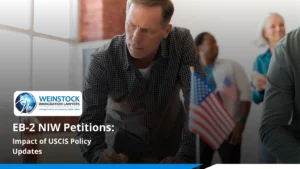H-1B Visa Ban Not Sustainable
The unemployment rate in computer and mathematical occupations remains well below pre-pandemic levels, making the current immigration ban on the entry of H-1B visa holders unsustainable.
On June 22, 2020, Donald Trump used his authority under section 212(f) of the Immigration and Nationality Act to issue a proclamation suspending the entry of H-1B, L-1, and other temporary visa holders. This followed a similar proclamation on April 22, 2020, that blocked the entry of nearly all categories of immigrants, including employment-based. Before leaving office, Trump extended the ban on entry for both the April and June proclamations until March 31, 2021.
Successful litigation in NAM v. DHS stopped the June 2020 proclamation for many employers. The judge’s opinion cited National Foundation for American Policy research on the low unemployment rate in computer occupations. However, for employers that were not members of the trade associations that engaged in the successful litigation, the ban remains in place on the entry of H-1B, L-1, H-2B, and certain J-1 visa holders. That includes university employers, public schools, nonprofit organizations, and others unable to join business organizations. (Some national interest exemptions have been possible.)
World Of Intelligent Systems
On February 24, 2021, the Biden administration revoked the proclamation issued on April 22, 2020, thereby no longer blocking the entry of immigrants in the Diversity visa, employment, and family categories.
The administration left in place the bans in the June 2020 proclamation, which blocks the entry of H-1B and other visa holders whose employers were not part of the order in NAM v. DHS. The justification for maintaining the suspension looks weak.
On October 1, 2020, when U.S. District Judge Jeffrey S. White ruled the president did not possess the power to issue the June 2020 proclamation, he referenced a June 2020 National Foundation for American Policy (NFAP) analysis. That analysis showed between January and May 2020 the U.S. unemployment rate in computer occupations had remained stable and actually declined (from 3.0% to 2.5%) in occupations that lined up with those of H-1B visa holders (based on DHS H-1B occupational data). That information was available at the time the June 2020 proclamation was issued.
In January 2021, in computer and mathematical occupations, the unemployment rate declined to 2.4%, compared to 3.0% in January 2020 (before the pandemic spread in the U.S.), according to the Bureau of Labor Statistics (BLS). In computer occupations, a somewhat narrower designation, the unemployment rate declined from 3.0% in January 2020 to 2.7% in January 2021, according to an analysis of the Bureau of Labor Statistics’ (BLS) Current Population Survey by the National Foundation for American Policy.
Judge White also wrote, “The statistics regarding pandemic-related unemployment actually indicate that unemployment is concentrated in service occupations and that a large number of job vacancies remain in the area most affected by the ban, computer operations which require high-skilled workers.” (Emphasis added.)
The statement on job vacancies referred to data presented by NFAP that showed, “During the 30-day period ending June 9, 2020, there were over 639,000 active job vacancy postings advertised online for jobs in common computer occupations, including those most common to H-1B visa holders, according to Emsi Job Posting Analytics. For example, there are over 260,000 active job vacancy postings advertised online for software developers (applications).”
What do the latest statistics show? Between June 9, 2020, and February 28, 2021, the number of active job vacancy postings advertised online for jobs in common computer occupations increased by 37% or 234,000 and now stands at over 873,000, according to an NFAP analysis of Emsi Job Posting Analytics. Instead of 260,000 active job vacancy postings advertised online for software developers (applications), there were over 368,000, an increase of 108,000 or more than 40%.
In revoking the April 22, 2020 proclamation blocking the entry of immigrants, the Biden administration was likely influenced by the litigation in Gomez v. Trump, as evidenced by the language in its February 24, 2021 proclamation that mentions Diversity and other immigrants. The American Immigration Lawyers Association (AILA), the Justice Action Center (JAC), and Innovation Law Lab filed the lawsuit with pro bono support from Mayer Brown LLP.
“Prior to the rescission of PP10014 [the April 22, 2020 proclamation], Judge Mehta granted our request for emergency relief on behalf of our class of DV2020 [Diversity] winners who had visas issued or renewed in September pursuant to his original injunction,” said Jesse Bless, AILA’s director of litigation, in an interview. “The judge preserved the validity of DV2020 visas and those individuals will now have the opportunity to enter the U.S. The visas will be treated as if they were issued as of February 24, 2021.”
Significant practical issues remain due to consular closings and backlogs for issuing immigrant and temporary (nonimmigrant) visas. In a March 1, 2021, briefing, the State Department asked for patience.
“They are acknowledging the problem but seem to be saying there is not much they can do about it at this time,” said Jeffrey Gorsky, senior counsel at Berry Appleman & Leiden and a former State Department attorney, in an interview. “The NIV/IV [nonimmigrant/immigrant visa] distinction should not be an issue. Almost all posts have separate NIV and IV units that do not compete for space. With both operating significantly under capacity, there should not be an issue of prioritizing one over the other. They should be able to get immigrant visa processing back to normal—and they say they are not ready to do that—without draining resources from nonimmigrant visas.”
“If the ban were to be extended beyond March 31, it would limit the ability of H-1B lottery beneficiaries to use the visa process, but there are exceptions that would limit the effectiveness of the ban,” said Gorsky. “It would not apply to the plaintiff class [in NAM v. DHS], assuming that the injunction holds, and there are national interest exceptions. And it does not apply to people who were in the U.S. on the effective date of 10052 (June 24, 2020). But the consular shutdown would probably have a greater impact, as it would inhibit visa processing on all classes and will remain in effect, subject to local conditions, even if the ban expires at the end of March.”
The business and legal community is sufficiently unclear of the Biden administration’s posture on H-1B and other temporary visas that there is uncertainty as to whether Biden will continue Trump’s June 2020 proclamation past March 31, 2021, despite there being no economic case for continuing it.
When running for president, Joe Biden said he would let the facts dictate his administration’s policies. The economic facts show the Trump administration’s ban on the entry of H-1B and other visa holders was faulty from the start, and the case for it has grown weaker with each passing month.
Source: Forbes.com
Related posts

Exploring Alternative Pathways: EB-2 NIW vs. EB-1A Green Card
Summary Two of the most sought-after green card options for highly qualified professionals are: EB-2 National Interest Waiver (NIW) EB-1A Extraordinary Ability visa Both allow

TN Visa for Remote or Hybrid Work: Navigating USMCA Rules
Summary If you’re a Canadian or Mexican entrepreneur living in the U.S. or planning to launch a business here, you may be wondering: Can I

Impact of USCIS Policy Updates on EB-2 NIW Petitions: What You Need to Know
Summary The EB-2 National Interest Waiver (NIW) offers a pathway to U.S. permanent residency without employer sponsorship, ideal for professionals and skilled workers. Recent USCIS
